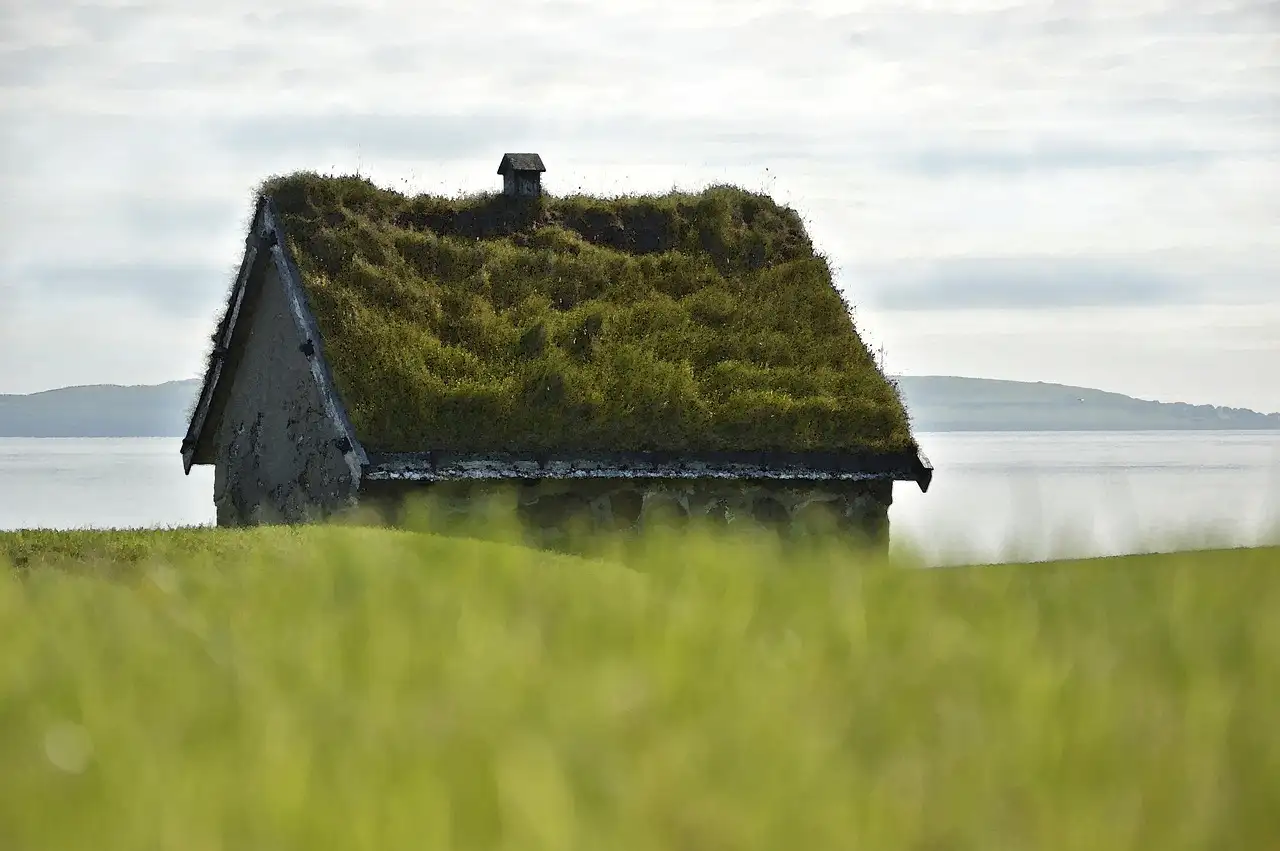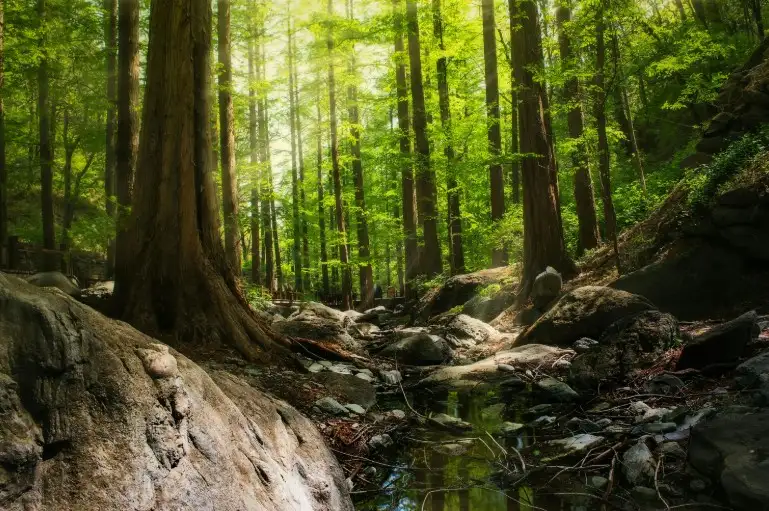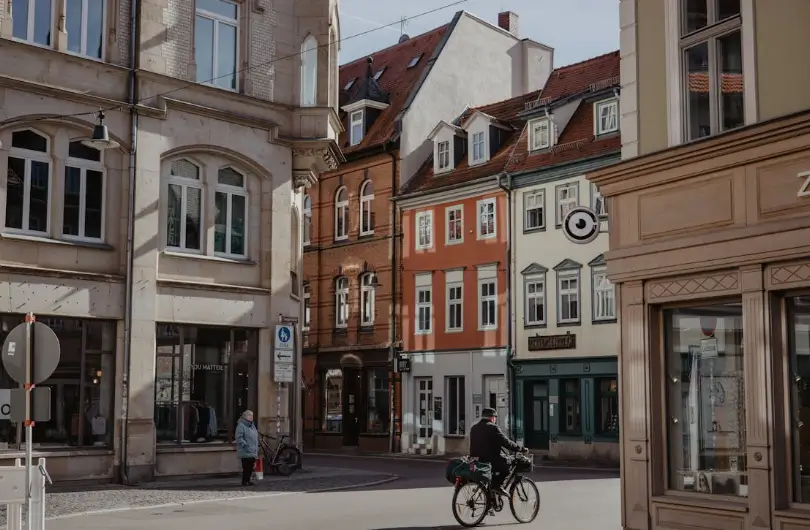City Design and what Planners Can Learn From Nature
Cities are often planned like machines: rigid, compartmentalized, and engineered for efficiency. But nature? Nature’s more like that weird neighbor with a beehive in the yard and a compost pile that somehow smells like oranges, unpredictable, layered, and beautifully resilient.
So maybe it’s time we stop trying to control every inch of urban life and start taking notes from the ecosystems around us. Nature doesn’t waste space. It adapts, regenerates, and works in networks. Oh, and it doesn’t pave over everything just because someone’s HOA complained about dandelions.
From distributed stormwater systems to organic, mixed-use communities (you know, like forests), nature reminds us that good design isn’t always about control but rather about relationships.
Nature’s Blueprint: More Than a Pretty Photo
Planning tends to lean hard into things like grids, zones, and setbacks. Everything gets a label and a boundary (set backs anyone)? On the other hand, nature doesn’t label its parts. It flows, adapts, regenerates, and thrives in a chaotic complexity that serves as a masterclass in systems thinking.
Planners, take note.
Now think of a forest for a second. Have you ever thought about the fact that a forest has no central command? There’s no overseeing gnome telling everything how to function (at least not that we know of), yet every part know how to function, connect, and adapt. That kind of distributed intelligence is a model planners might do well to learn from. Because not every solution comes from a spreadsheet...or GIS for that matter (Gasp! Blasphemy...I know). Sometimes, it comes from watching moss grow on a rock and realizing it knows exactly what it’s doing.

Ecosystem Efficiency
In nature, there’s no waste. One creature’s leftovers become another’s survival in an elegant, closed-loop system where nothing is discarded, just repurposed. Can our cities function in a similar manner? Maybe. The Mobius Project in the UK, designed by Yaniv Peer (Exploration Architecture, now Iguana Architects), is a visionary urban agriculture initiative for London, centered around Keble Old Street Roundabout. It’s intended to be a biomimetic, zero‑waste urban ecosystem (try to say that ten times fast). Think greenhouses, composting, aquaculture, mushroom production, and food‑market spaces, where what's produced from one process feeds into another, creating a continuous loop. Can you imagine a city that functions more like this? More like a forest: self-sustaining, self-regulating, and weirdly efficient without the need to hire a consultant just to define the term "sustainable."
Adaptive Infrastructure
After China’s devastating 2012 floods, landscape architect Yu Kongjian introduced the now-famous “sponge city” concept. This concept looks at the urban fabric and finds opportunities for green spaces, permeable surfaces, and restored waterways that can be designed to absorb and manage water, rather than fight it. Most cities today treat stormwater by draining it away into a river, a reservoir, anywhere but city streets. But when we rush water away through pipes and channels, we strip the land of its ability to naturally refill its underground water supply (or recharge). This also increases downstream flooding, erodes creeks, and fails to use stormwater as a resource. It’s like flushing away free water and then complaining about droughts.
However, sponge cities slow down water runoff, allowing the land to soak it up and breathe. It's a design philosophy that blends ecology and engineering.
Rotterdam has embraced similar thinking with its tidal parks. River as Tidal Park is a multi‑partner initiative launched between 2014–2017, led by Rotterdam’s national government, WWF/ARK, and the Port Authority. It aims to reinvent hard riverbanks along the Nieuwe Maas into green, tidal‑dynamic public spaces, offering a different option for water management rather than sheer walls. The tidal park concept introduces soft edges such as vegetated terraces and estuarine zones (areas where a river meets the sea), that flood and drain with the tides. It's a sophisticated yet natural shift from "flood control" to "flood coexistence." These parks double as green infrastructure and social spaces, helping cities adapt to climate realities while enhancing quality of life.
Biophilic Design = Human Flourishing
Speaking of quality of life, it's a well-documented psychological fact that looking at plants makes people calmer. But it's not just about "feeling good". Exposure to greenery has been shown to lower blood pressure, reduce stress hormones, improve concentration, and even shorten recovery times in hospitals. That’s why hospitals, offices, schools, and even prisons are increasingly incorporating green space in the form of pocket gardens, living walls, or trees outside windows.
Our brains respond instinctively to natural environments, even in small doses. A single tree-lined street or patch of native grasses can have measurable effects on our mood and our ability to focus. Biophilic design brings that reality into our cities. It’s a design concept that develops buildings and cities in ways that help people feel more connected to the natural world by doing things like adding indoor plants, using natural light, building with wood or stone, and creating green spaces nearby. The idea is that humans are healthier, happier, and more productive when our surroundings remind us of nature.
.jpg)
Look at Singapore’s Gardens by the Bay. Launched through an international competition in 2006, Gardens by the Bay brought to life the Singapore National Parks Board’s vision of becoming a true “City in a Garden.” Grant Associates (Bay South) and Gustafson Porter (Bay East) led the winning designs. The 130-acre layout takes inspiration from Singapore’s national flower, the orchid. Conservatories act as the flower, pathways and utility lines as roots and shoots, with Supertrees and theme gardens as blooms.
Planning Lessons from Natural Systems
As planners, we can learn a great deal from looking at natural systems.
Think in Loops, Not Lines
Nature is full of cycles, like the water cycle, where rain becomes rivers, then evaporates into clouds and starts again. Or the nutrient cycle, where plants grow, decompose, and feed the soil that grows new plants. Even animal migration and seasonal growth are examples of natural patterns repeating over time. Instead of just funneling stormwater into drains and hoping for the best, planners can design systems that actually use that water. Things like bioswales, rain gardens, and permeable streets. These features let water soak into the ground naturally, help recharge the water table, reduce flooding, and take pressure off aging infrastructure. Why reinvent the wheel... or in this case, the cycle?

But there’s another cycle we often overlook: the nutrient cycle. In nature, organic matter—like fallen leaves, dead plants, or animal waste, breaks down and returns to the soil, feeding the next generation of growth. It’s compost before compost bins were cool. In planning terms, this could mean designing urban systems that turn waste into resource. Food scraps become community compost. Tree trimmings feed soil in local parks. Even human waste, if treated appropriately, can be reimagined as part of a regenerative system. I know, kinda gross to think about but it's something we have to deal with. If the water cycle teaches us how to move resources wisely, the nutrient cycle teaches us how to reuse them smartly.
Build-In Adaptability
Trees and wetlands don’t panic when it floods, they’re literally built for it. Roots hold the soil, branches slow the water, and entire ecosystems bounce back without a memo from City Hall. Urban landscapes should follow that lead and our codes should facilitate their installation. Whether it’s floating parks that rise with the water, flexible floodplains that double as recreation space, or zoning that allows buildings to shift in use over time, cities gain long-term resilience when they stop resisting change and start planning for it.
Embrace Diversity
Species diversity in nature is crucial for ecosystem health. If one plant fails, others fill in. If one species disappears, another steps up. This layered resilience means ecosystems can bounce back from drought, disease, or disruption. In cities, that same thinking translates to diversity in housing types, land uses, jobs, and transportation. A neighborhood with only one type of home, one way to get around, or one kind of job is vulnerable to economic shifts and environmental change. But a city that mixes apartments with duplexes, retail with green space, and bike lanes with buses is a city designed to survive, adapt, and thrive. It’s like planting a forest instead of a cornfield, less efficient on paper, but far more sustainable over time.
Follow Nature’s Scale
Nature works from micro (like the hidden networks of fungi and microbes in soil) to macro (like sprawling river corridors, mountain ranges, and migratory paths). Every scale serves a purpose and connects to the others. Planners need to think in these layers too: at the building scale with green roofs and passive solar design, at the neighborhood scale with street trees, bioswales, and community gardens, and at the regional scale with greenbelts, wildlife corridors, and watershed planning. Just like nature, a resilient city is one where every layer of scale supports the next.
Real-World Case Studies
Some cities are taking notice and reimagining their urban design efforts. Notable examples include:
Lavasa, India – Designers replicated forest functions (like tree roots and ant-like storm channels) to handle monsoons and stabilize soil.
Bishan-Ang Mo Kio Park (Singapore) – An old canal was “de-greyed” and returned to its natural river form, improving flood control, biodiversity, and public space.
Benjakitti Forest Park (Bangkok) – Built on a former parking lot and designed to hold a 10-year storm event like a sponge.
Keilehaven Tidal Park (Rotterdam) – Integrates tidal patterns into city design, buffering sea-level rise while creating habitat and recreation space.
What Should Planners Do Tomorrow?
Planners looking to nature for inspiration can take several practical steps. For stormwater, instead of traditional pipes and drains, they can push for the use of permeable pavements, rain gardens, and sponge parks. These are solutions that absorb water like the ground in a forest. As for buildings, they can benefit from green roofs, natural shading, and better ventilation, mimicking how trees regulate temperature and airflow. When it comes to streets, advocating for policies that require more tree planting and canopy-style design can help reduce urban heat and make neighborhoods more walkable. At the neighborhood level, encouraging mixed-use development and integrating green corridors can foster more resilient and connected communities. And across infrastructure systems, designing for flexibility and multiple uses, like a park that also handles floodwaters, ensures that cities are equipped to adapt, not just endure.

Why It Matters
These systems make cities more climate-resilient and overall healthier. They are designed to bend, not break, when challenges like flooding or extreme heat arise. Rich greenery and access to nature also help people feel calmer, stay cooler, and live healthier lives. On top of that, natural solutions like rain gardens or green roofs often cost less than massive infrastructure projects. And honestly, who prefers a parking lot over a park?
Final Thoughts
Nature doesn't sustain itself by accident. It evolved to thrive in uncertain conditions and we can borrow that blueprint. Cities thrive when they follow nature's logic. That means using cycles so systems can renew themselves instead of burning out. It means building adaptability into every plan, allowing places to evolve rather than break under pressure. We need to encourage diversity at all scales, because variety builds resilience. And above all, we should think both small and big because micro-decisions ripple into regional impacts. Planning isn’t just about efficiency. It’s about what can grow. Because cities can be more than machines. They can be ecosystems with planners as gardeners, not assembly-line supervisors.
Up next: How Urban Food Forests Cool Cities Down
%20(1200%20x%20237%20px)%20(300%20x%2059%20px).webp)


.webp)


